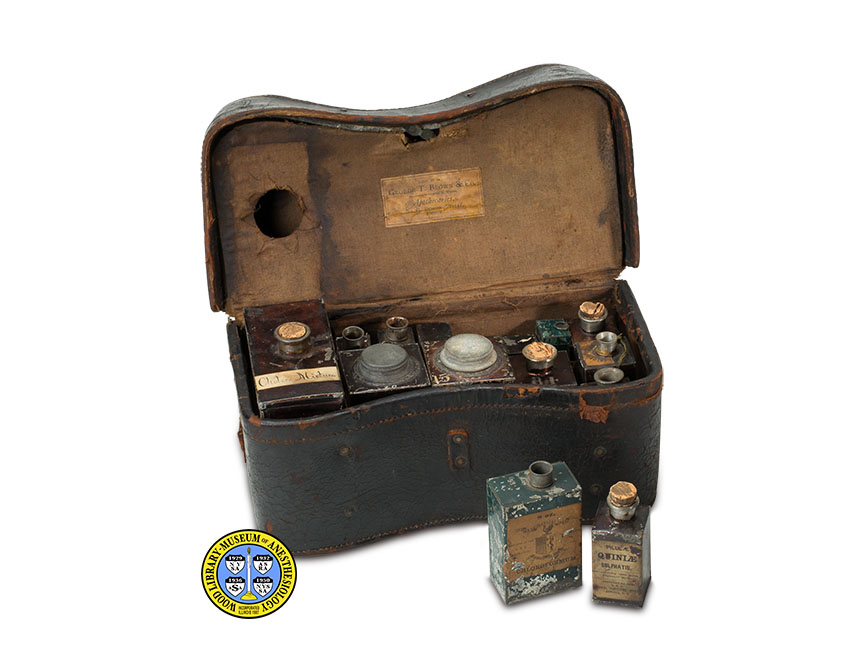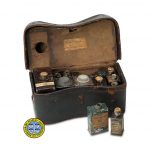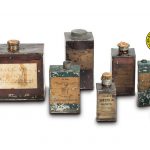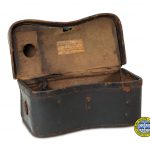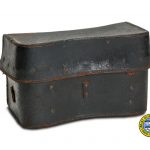Surgeon’s Field Companion
Richard H. Coolidge, M.D. (1816-1866), a Medical Inspector and Assistant Surgeon for the U.S. Army, designed this field case in 1863 for the use of Union surgeons during the Civil War.
The Civil War began 17 years after the first successful public demonstration of ether anesthesia. This was the first American military conflict in which anesthetics were routinely employed by the armed forces. The armies of both the Union and the Confederacy preferred chloroform for treating wounded soldiers, although ether was also used.
Not all soldiers who underwent surgery during the Civil War received an anesthetic. Some physicians believed anesthesia was unsafe and preferred to perform surgery without it. Problems with supply and distribution also resulted in emergency surgeries being performed without anesthesia (the so-called “bite-the-bullet” surgeries).
The full Surgeon’s Field Companion included chloroform, ipecacuanha in pill and liquid form, ginger, persulphate of iron, whiskey, opium in pill and liquid form, cathartic pills, colocynth, sulphate of quinine pills, isinglass plaster, lint, muslin and a towel, as well as a medicine cup, scissors, teaspoon, pins, two dozen bandages, and corks. The kit shown here no longer has the shoulder or waist straps that would have steadied and supported the case when it was being carried. The large whiskey tin that was acquired with this case was relabeled with handwritten directions and a list of contents for “Hamlin’s Cholera Mixture.”
Catalog Record: Surgeon’s Field Companion
Access Key: amdo
Accession No.: 2006-05-09-2
Title: [Surgeon’s field companion] / [designed by R. H. Coolidge].
Author: Coolidge, Richard H. (Richard Henry), 1816-1866.
Title variation: Alt Title
Title: Surgeon’s companion.
Title variation: Alt Title
Title: Coolidge surgeon’s field companion.
Title variation: Alt Title
Title: Surgeon’s field case.
Publisher: [Location of manufacturer not indicated] : [U.S. Army?] ; Boston : put up by
George T. Brown & Co.; [between 1863 and 1865?].
Physical Descript: 1 medical case and contents : leather, textile, metals ; 20 x 34 x 18.5 cm.
Subject: American Civil War.
Subject: Military Medicine – instrumentation.
Note Type: General
Notes: The title was taken from The Medical and Surgical History of the Civil War,
volume XII (12), republished in 1991 by Broadfoot Publishing Company (page
915). The name of the designer, and the form of that name, was taken from the
same page of this publication.
Note Type: General
Notes: The date range for the possible year of manufacture is an estimate for the
leather case only. The early year is based on the date provided in the
description on page 915 of The Medical and Surgical History of the Civil War
(republication of 1991) : “In the early part of 1863 Medical Inspector R. H.
Coolidge, U.S.A., arranged a field case or companion … to take the place of
the knapsack.” The end date is based on the year the American Civil War
ended.
Note Type: With
Notes: Photographed with four items from another acquisition: 2003-12-21-1. These
includes a burgundy lacquered tin for “TINCT. OPII.”, measuring approximately
11.5 x 3 x 3 cm (the accession number is 2003-12-21-1 B); The tin has no cork
and a small metal loop on the right-back edge of the shoulder; Other
markings on the label include “Maris & Co.” and “Phila’d”; The second item is
a burgundy lacquered tin for “EXT : ZINGIBER FLUIDUM [new line] FLUIDUM”,
measuring approximately 11.5 x 3 x 3 cm (2003-12-21-1 E); Other markings on
the label include “Maris & Co.” and “Phila’d”; The third item is a burgundy
tin marked at the top, “CHLOROFORMUM” (2003-12-21-1 D); This tin has no cork
and measures approximately 11.5 x 4 x 4 cm; A a small metal loop on the neck
of the tin has a short green string tied to it; The fourth item is a burgundy
lacquered tin with a square lid/cap and measures approximately 9 x 3 x 3 cm
(2003-12-21-1 A); Text on the label includes, “PIL COLOC : ET IPECAC. [new
line] 3 gr. Col: 1/2 gr. Ip. [new line] Maris & Co. [space] Phila’d”.
Note Type: Citation
Notes: Albin MS. The use of anesthetics during the Civil War, 1861-1865. Pharm Hist.
2000;42(3-4):99-114.
Note Type: Citation
Notes: Barnes JK; United States Surgeon-General’s Office. The Medical and Surgical
History of the Civil War. Wilmington, N.C.: Broadfoot Publishing Company;
1991:915,946-947.
Note Type: Physical Description
Notes: One leather case with tins; When the lid is closed the case measures
approximately 20 x 34 x 18.5 cm in height, width and depth; (The accession
number for the case is 2006-05-09-2 A); The lid has a hinged inner ‘false
bottom’ to support and secure contents stored above it; The bottom portion of
the case is divided into four rectangular spaces of different sizes; A page
label is attached to one side of the ‘false bottom’ of the lid; The text on
it reads, “PUT UP BY [new line] GEORGE T. BROWN & CO. [new line] SUCCESSORS
TO SAMUEL H. WOODS [new line] Apothecaries [new line] NO. 15 BEACON STREET,
[new line] BOSTON”; A label on the back of the case is torn and only some
letters are visible, “2nd [tear] Batt;; [tear] VM”; Eleven tin accompanied
the case in acquisition; These include the largest corked tin, 12.5 x 13 x 6
cm (2006-05-09-2 B); It has a burgundy color lacquer and handwritten paper
labels; This tin may have originally been for whiskey; The text on the label
on the top of the tin is, “Cholera Mixture.”; Text on the front of the tin
includes, “Hamlins Cholera Mixture [new line] One part each of Laudanum Tinct
camphor and two parts Tinct Rhubarb [new line] “Directions.” Thirty to forty
drops to be repeated in urgent cases. – If rejected by vomiting, repeat the
dose.”; There is also a burgundy lacquered tin with a screw cap marked “BLACK
TEA” (2006-05-09-2 K); It measures approximately 12.5 x 6.5 x 6.5 cm;
Another burgundy lacquered tin with a screw cap is marked “WHITE CRUSHED
SUGAR [new line] U.S.A. MEDICAL PURVEYING DEPOT.” (2006-05-09-2 L); It
measures 12.5 x 6.5 x 6.5 cm; A burgundy lacquered tin with a square cap is
marked, “PIL. QUINIAE SULP. [new line] 3 grs.” (2006-05-09-2 G); It measures
approximately 10 x 3 x 3 cm; An unlabeled burgundy lacquered tin with a
broken cork measures approximately 9.5 x 4 x 4 cm (accession number is
possibly 2006-05-09-2 C); An unlabeled, burgundy lacquered tin without a cork
measures approximately 11 x 4 x 4 cm (006-05-09-2 J); The metal on the bottom
of the tin has eroded enough to create a hole; A green lacquered tin with a
square hinged lid measures approximately 10 x 3 x 2.5 cm (2006-05-09-2 H);
Markings on the label include “8 doz. [new line] U.S.A. Medical Dept.” [new
line, illustration of a rooster, new line] PREPARED AT THE U.S.A. LABORATORY
[a coat of arms] PHILADELPHIA [new line] PA [new line] 1864 [new line]
Pilul[ae] Quiniae Sulp[atis] [?} grs.”; An unlabeled, corked tin measures
approximately 11.5 x 4 x 4 cm (2006-05-09-2 I); A green, uncorked tin
measures approximately 10.5 x 6 x 3.5 cm (2006-05-09-2 D); A small metal loop
at the next has a small brown string tied in it; Text on the label includes,
“[new line] U.S.A. Medical Dept.” [new line, illustration of a rooster, new
line] PREPARED AT THE U.S.A. LABORATORY [a coat of arms] PHILADELPHIA [new
line] PA [new line] 1863 [new line] EXPERIENTIA PROGRESSUS [new line]
CHLOROFORMUM.”; A corked burgundy lacquered tin, measuring approximately 9.5
x 4 x 4 cm, is marked with, “PILULAE [new line] QUINIAE [new line] SULPHATIS.
[new line] Each containing three grains of sulphate of Quinia. [new line]
PREPARED AT THE [new line] U.S.A. [new line] MEDICAL PURVEYING DEPOT [new
line] ASTORIA, L.I.” (2006-05-0902 F); A burgundy lacquered tin with a broken
cork, measuring approximately 11.5 x 5 x 5 cm, is marked with, “PILULAE [new
line] QUINIAE [new line] SULPHATIS. [new line] Each containing three grains
of sulphate of Quinia. [new line] PREPARED AT THE [new line] U.S.A. [new
line] MEDICAL PURVEYING DEPOT [new line] ASTORIA, L.I.” (2006-05-0902 E).
Note Type: Reproduction
Notes: Photographed by Mr. Steve Donisch, January 13, 2015. Photographed with items
from another acquisition: 2003-12-21-1. This includes a tin for “TINCT. OPII.
“, a tin for “EXT : ZINGIBER FLUIDUM.”, a tin for “CHLOROFORMUM”, and a tin
for “PIL COLOC : ET IPECAC.”
Note Type: Historical
Notes: Richard H. Coolidge, M.D. (1816-1866), a Medical Inspector and Assistant Surgeon for the U.S. Army, designed this field case in 1863 for the use of Union surgeons during the Civil War.
The Civil War began 17 years after the first successful public demonstration of ether anesthesia. This was the first American military conflict in which anesthetics were routinely employed by the armed forces. The armies of both the Union and the Confederacy preferred chloroform for treating wounded soldiers, although ether was also used.
Not all soldiers who underwent surgery during the Civil War received an anesthetic. Some physicians believed anesthesia was unsafe and preferred to perform surgery without it. Problems with supply and distribution also resulted in emergency surgeries being performed without anesthesia (the so-called “bite-the-bullet” surgeries).
The full Surgeon’s Field Companion included chloroform, ipecacuanha in pill and liquid form, ginger, persulphate of iron, whiskey, opium in pill and liquid form, cathartic pills, colocynth, sulphate of quinine pills, isinglass plaster, lint, muslin and a towel, as well as a medicine cup, scissors, teaspoon, pins, two dozen bandages, and corks. The kit shown here no longer has the shoulder or waist straps that would have steadied and supported the case when it was being carried. The large whiskey tin that was acquired with this case was relabeled with handwritten directions and a list of contents for “Hamlin’s Cholera Mixture.”
Note Type: Publication
Notes: Albin MS. In praise of anesthesia: Two case studies of pain and suffering
during major surgical procedures with and without anesthesia in the United
States Civil War-1861–65. Scandinavian J Pain. 2013;4(4):243-246.
Note Type: Exhibition
Notes: Selected for the WLM website (noted July, 2015); An image of the filled case
was used in a Summer 2006 WLM marketing flier.
